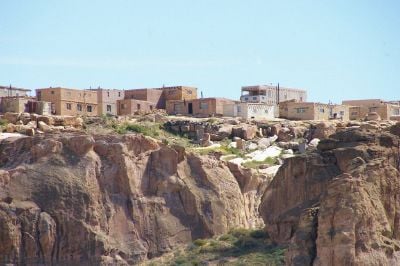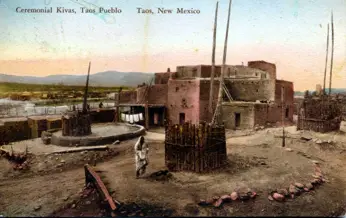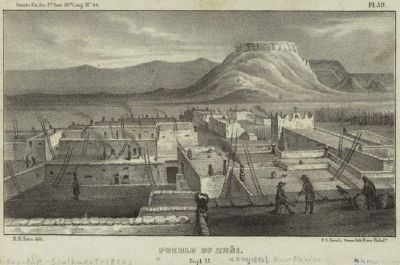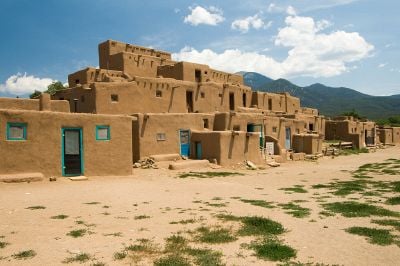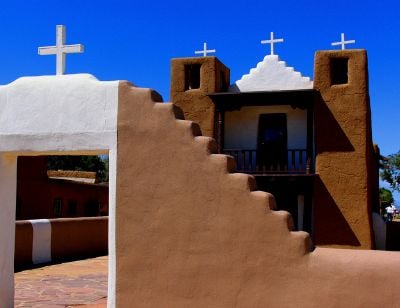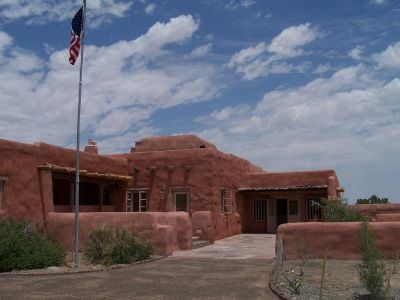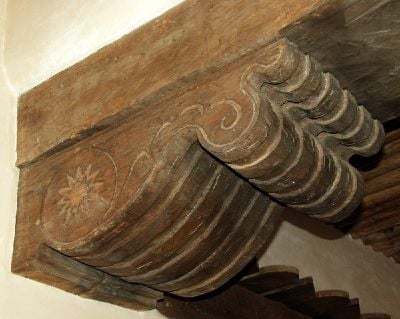Difference between revisions of "Pueblo" - New World Encyclopedia
| (7 intermediate revisions by 2 users not shown) | |||
| Line 5: | Line 5: | ||
{{otheruses4|the communities of [[apartment]]-like structures in the Southwestern [[United States of America]]|the people who live in these communities|Pueblo People}} | {{otheruses4|the communities of [[apartment]]-like structures in the Southwestern [[United States of America]]|the people who live in these communities|Pueblo People}} | ||
| − | [[Image:Acoma Pueblo Sky City 2.jpg|thumb| | + | [[Image:Acoma Pueblo Sky City 2.jpg|thumb|400 px|Acoma Pueblo, known as "Sky City"]] |
'''Pueblo''' is a term used to describe modern (and ancient) communities of [[Native Americans in the United States|Native Americans]] in the Southwestern part of what is now the [[United States of America]]. The first [[Spain|Spanish]] explorers of the Southwest used this term to describe communities that consisted of [[apartment]]-like structures made from stone, [[adobe]] mud, and other local material, which provided excellent insulation from cold in winter and heat in summer. They were usually multi-storeyed buildings surrounding an open [[plaza]] and were occupied by hundreds to thousands of [[Puebloan peoples|Pueblo People]]. Designed for defense as well as [[shelter]], pueblos were often built atop steep [[mesa]]s. Another defensive aspect was a lack of doors on the ground level, requiring entry from the roof top reached by ladders that were withdrawn in times of danger. Today, pueblos have doors on the ground level. Pueblo People still inhabit a number of these villages, which date back a thousand years making them the oldest continuously occupied dwellings in North America. | '''Pueblo''' is a term used to describe modern (and ancient) communities of [[Native Americans in the United States|Native Americans]] in the Southwestern part of what is now the [[United States of America]]. The first [[Spain|Spanish]] explorers of the Southwest used this term to describe communities that consisted of [[apartment]]-like structures made from stone, [[adobe]] mud, and other local material, which provided excellent insulation from cold in winter and heat in summer. They were usually multi-storeyed buildings surrounding an open [[plaza]] and were occupied by hundreds to thousands of [[Puebloan peoples|Pueblo People]]. Designed for defense as well as [[shelter]], pueblos were often built atop steep [[mesa]]s. Another defensive aspect was a lack of doors on the ground level, requiring entry from the roof top reached by ladders that were withdrawn in times of danger. Today, pueblos have doors on the ground level. Pueblo People still inhabit a number of these villages, which date back a thousand years making them the oldest continuously occupied dwellings in North America. | ||
| Line 13: | Line 13: | ||
==Etymology and usage== | ==Etymology and usage== | ||
The [[Spanish language|Spanish]] word ''pueblo'', evolved from the [[Latin]] word ''populus'' (people), meaning "town." The Spanish explorers discovered [[Native American]]s living in these clusters of dwellings when they reached the Southwest in the sixteenth century: | The [[Spanish language|Spanish]] word ''pueblo'', evolved from the [[Latin]] word ''populus'' (people), meaning "town." The Spanish explorers discovered [[Native American]]s living in these clusters of dwellings when they reached the Southwest in the sixteenth century: | ||
| − | <blockquote>On the central Spanish meseta the unit of settlement was and is the ''pueblo''; that is to say, the large nucleated village surrounded by its own fields, with no outlying farms, separated from its neighbours by some considerable distance, sometimes as much as ten miles or so. The demands of agrarian routine and the need for defence, the simple desire for human society in the vast solitude of the plains, dictated that it should be so. Nowadays the pueblo might have a population running into thousands. Doubtless they were smaller in the early middle ages, but we should probably not be far wrong if we think of them as having had populations of some hundreds.<ref>Richard A. Fletcher, ''Saint James's Catapult: The Life and Times of Diego Gelmírez of Santiago de Compostela'' | + | <blockquote>On the central Spanish meseta the unit of settlement was and is the ''pueblo''; that is to say, the large nucleated village surrounded by its own fields, with no outlying farms, separated from its neighbours by some considerable distance, sometimes as much as ten miles or so. The demands of agrarian routine and the need for defence, the simple desire for human society in the vast solitude of the plains, dictated that it should be so. Nowadays the pueblo might have a population running into thousands. Doubtless they were smaller in the early middle ages, but we should probably not be far wrong if we think of them as having had populations of some hundreds.<ref>Richard A. Fletcher, ''Saint James's Catapult: The Life and Times of Diego Gelmírez of Santiago de Compostela'' (Oxford: Oxford University Press, 1984, ISBN 0198225814). </ref></blockquote> |
In the local language of the inhabitants, the pueblo is referred to as "the village." | In the local language of the inhabitants, the pueblo is referred to as "the village." | ||
==Historical Pueblos== | ==Historical Pueblos== | ||
| − | [[Image:Taospueblo002.jpg|right|thumb| | + | [[Image:Taospueblo002.jpg|right|thumb|400 px|Taos Pueblo, circa 1920]] |
| − | [[Image:ZuniPueblo1850.jpg|thumb|right| | + | [[Image:ZuniPueblo1850.jpg|thumb|right|400 px|Zuni Pueblo, 1850 illustration]] |
[[Pre-Columbian]] towns and villages in the Southwest were located in defensive positions, for example, on high steep [[mesa]]s such as [[Acoma Pueblo|Acoma]]. Their large, multi-family houses were called ''pueblos'' by the Spanish when they arrived in the sixteenth century. These early residents of the area are often referred to as [[Pueblo people|puebloan culture]]s: "The Late Puebloan cultures built the large, integrated villages found by the Spaniards when they began to move into the area."<ref name=Ivey> James E. Ivey, ''In the Midst of a Loneliness: The Architectural History of the Salinas Missions'' (University of Michigan Library, 1988).</ref> | [[Pre-Columbian]] towns and villages in the Southwest were located in defensive positions, for example, on high steep [[mesa]]s such as [[Acoma Pueblo|Acoma]]. Their large, multi-family houses were called ''pueblos'' by the Spanish when they arrived in the sixteenth century. These early residents of the area are often referred to as [[Pueblo people|puebloan culture]]s: "The Late Puebloan cultures built the large, integrated villages found by the Spaniards when they began to move into the area."<ref name=Ivey> James E. Ivey, ''In the Midst of a Loneliness: The Architectural History of the Salinas Missions'' (University of Michigan Library, 1988).</ref> | ||
| Line 32: | Line 32: | ||
==Contemporary Pueblos== | ==Contemporary Pueblos== | ||
| − | [[Image:USA_09669_Taos_Pueblo_Luca_Galuzzi_2007.jpg| | + | [[Image:USA_09669_Taos_Pueblo_Luca_Galuzzi_2007.jpg|400px|thumb|Taos Pueblo residential complex]] |
| − | [[Image:Taos Pueblo Church2.jpg|thumb|right| | + | [[Image:Taos Pueblo Church2.jpg|thumb|right|400px|San Geronimo Church at Taos Pueblo]] |
The people of some pueblos still inhabit centuries-old [[adobe]] pueblo buildings.<ref name="Gibson">Daniel Gibson, ''Pueblos of the Rio Grande: A Visitor's Guide'' (Tucson, AZ: Rio Nuevo Publishers, 2001, ISBN 1887896260), 78.</ref> Acoma Pueblo, also known as "Sky City," was built on top of a 367-foot (112 m) [[sandstone]] mesa in [[New Mexico]]. Settled around 1100, it is one of the oldest continuously inhabited communities in the United States. | The people of some pueblos still inhabit centuries-old [[adobe]] pueblo buildings.<ref name="Gibson">Daniel Gibson, ''Pueblos of the Rio Grande: A Visitor's Guide'' (Tucson, AZ: Rio Nuevo Publishers, 2001, ISBN 1887896260), 78.</ref> Acoma Pueblo, also known as "Sky City," was built on top of a 367-foot (112 m) [[sandstone]] mesa in [[New Mexico]]. Settled around 1100, it is one of the oldest continuously inhabited communities in the United States. | ||
Taos Pueblo is another ancient pueblo, approximately 1000 years old. The church at Taos Pueblo is the newest building in the pueblo having been built in 1850 to replace the original pueblo church which was destroyed by the US army in 1847. | Taos Pueblo is another ancient pueblo, approximately 1000 years old. The church at Taos Pueblo is the newest building in the pueblo having been built in 1850 to replace the original pueblo church which was destroyed by the US army in 1847. | ||
| − | There are 21 federally recognized Pueblos<ref>Department of the Interior, Bureau of Indian Affairs, [ | + | There are 21 federally recognized Pueblos<ref>Department of the Interior, Bureau of Indian Affairs, [https://www.govinfo.gov/content/pkg/FR-2002-07-12/pdf/02-17508.pdf "Indian Entities Recognized and Eligible To Receive Services From the United States Bureau of Indian Affairs; Notice"] ''Federal Register'' 67(134) (July 12, 2002). Retrieved December 14, 2023.</ref> that are home to [[Pueblo people]]: |
{| | {| | ||
| | | | ||
| Line 48: | Line 48: | ||
*[[Isleta Pueblo, New Mexico|Pueblo of Isleta]], New Mexico | *[[Isleta Pueblo, New Mexico|Pueblo of Isleta]], New Mexico | ||
*[[Laguna Pueblo|Pueblo of Laguna]], New Mexico | *[[Laguna Pueblo|Pueblo of Laguna]], New Mexico | ||
| − | |||
*[[Nambé Pueblo, New Mexico|Pueblo of Nambe]], New Mexico | *[[Nambé Pueblo, New Mexico|Pueblo of Nambe]], New Mexico | ||
*[[Picuris Pueblo, New Mexico|Pueblo of Picuris]], New Mexico | *[[Picuris Pueblo, New Mexico|Pueblo of Picuris]], New Mexico | ||
| Line 56: | Line 55: | ||
*[[Sandia Pueblo|Pueblo of Sandia]], New Mexico | *[[Sandia Pueblo|Pueblo of Sandia]], New Mexico | ||
*[[Santa Ana Pueblo, New Mexico|Pueblo of Santa Ana]], New Mexico | *[[Santa Ana Pueblo, New Mexico|Pueblo of Santa Ana]], New Mexico | ||
| − | |||
*[[Santa Clara Pueblo, New Mexico|Pueblo of Santa Clara]], New Mexico | *[[Santa Clara Pueblo, New Mexico|Pueblo of Santa Clara]], New Mexico | ||
*[[Santo Domingo Pueblo, New Mexico|Pueblo of Santo Domingo]], New Mexico | *[[Santo Domingo Pueblo, New Mexico|Pueblo of Santo Domingo]], New Mexico | ||
| Line 67: | Line 65: | ||
==Pueblo Revival Style Architecture== | ==Pueblo Revival Style Architecture== | ||
| − | [[Image:PaintedDesertInn.JPG|thumb| | + | [[Image:PaintedDesertInn.JPG|thumb|400px|[[Painted Desert Inn]], a [[National Historic Landmark]] in Arizona]] |
| − | [[Image:BAND beam exb.jpg|thumb| | + | [[Image:BAND beam exb.jpg|thumb|400px|'''Pueblo Revival''' [[corbel]], hand-carved from [[ponderosa pine]], at the [[Bandelier National Monument]] Visitor Center]] |
The Pueblo Revival Style is a regional [[architectural style]] of the [[Southwestern United States]] which draws its inspiration from the Pueblos and the [[Spanish missions in New Mexico]]. The style developed at the turn of the twentieth century and reached its greatest popularity in the 1920s and 1930s, though it is still commonly used for new buildings. Pueblo style [[architecture]] is most prevalent in the state of [[New Mexico]]. | The Pueblo Revival Style is a regional [[architectural style]] of the [[Southwestern United States]] which draws its inspiration from the Pueblos and the [[Spanish missions in New Mexico]]. The style developed at the turn of the twentieth century and reached its greatest popularity in the 1920s and 1930s, though it is still commonly used for new buildings. Pueblo style [[architecture]] is most prevalent in the state of [[New Mexico]]. | ||
| Line 77: | Line 75: | ||
The Pueblo Revival Style made its first appearance in New Mexico at the [[University of New Mexico]] in [[Albuquerque, New Mexico|Albuquerque]], where it was adopted by president [[William G. Tight]] for a number of projects completed during his tenure. The best-known of these was his 1908 remodeling of [[Hodgin Hall]], though a new heating plant and the ''[[Estufa]]'', a [[fraternity]] house, were completed earlier. Nearly all subsequent university buildings have also employed the Pueblo style, albeit in increasingly loose interpretations.<ref>Van Dorn Hooker, ''Only in New Mexico: An Architectural History of the University of New Mexico, the First Century 1889-1989'' Albuquerque, NM: University of New Mexico Press, 2000, ISBN 0826321356).</ref> | The Pueblo Revival Style made its first appearance in New Mexico at the [[University of New Mexico]] in [[Albuquerque, New Mexico|Albuquerque]], where it was adopted by president [[William G. Tight]] for a number of projects completed during his tenure. The best-known of these was his 1908 remodeling of [[Hodgin Hall]], though a new heating plant and the ''[[Estufa]]'', a [[fraternity]] house, were completed earlier. Nearly all subsequent university buildings have also employed the Pueblo style, albeit in increasingly loose interpretations.<ref>Van Dorn Hooker, ''Only in New Mexico: An Architectural History of the University of New Mexico, the First Century 1889-1989'' Albuquerque, NM: University of New Mexico Press, 2000, ISBN 0826321356).</ref> | ||
| − | The other stronghold of Pueblo style architecture is [[Santa Fe, New Mexico|Santa Fe]], where it was popularized in the 1920s and 1930s by a group of artists and architects seeking to establish a unique regional identity, and in particular to distinguish themselves from the spreading image of Southern [[California]]. Such was its popularity that it is often referred to as the "Santa Fe Style."<ref> | + | The other stronghold of Pueblo style architecture is [[Santa Fe, New Mexico|Santa Fe]], where it was popularized in the 1920s and 1930s by a group of artists and architects seeking to establish a unique regional identity, and in particular to distinguish themselves from the spreading image of Southern [[California]]. Such was its popularity that it is often referred to as the "Santa Fe Style."<ref>Henry Parker, [https://todayshomeowner.com/blog/guides/pueblo-revival/ Pueblo Revival Architectural Style] ''Today's Homeowner'' (November 12, 2023). Retrieved December 14, 2023.</ref> In 1957 a committee led by architect [[John Gaw Meem]] drafted the Historical Zoning Ordinance, which mandated the use of the Pueblo Style or Territorial Style on all new buildings in central Santa Fe. This ordinance remains in effect, meaning the Pueblo Style continues to predominate.<ref>Richard Harris, ''National Trust Guide: Santa Fe'' (New York, NY: John Wiley & Sons, Inc, 1997, ISBN 0471174432), 3-6.</ref> |
Pueblo style houses are still frequently constructed in Albuquerque, Santa Fe, and elsewhere. Updated versions of the style have also been used for newer commercial and public buildings such as the [[Albuquerque International Sunport]] terminal (1966) and the newer University of New Mexico buildings. | Pueblo style houses are still frequently constructed in Albuquerque, Santa Fe, and elsewhere. Updated versions of the style have also been used for newer commercial and public buildings such as the [[Albuquerque International Sunport]] terminal (1966) and the newer University of New Mexico buildings. | ||
| Line 116: | Line 114: | ||
==External links== | ==External links== | ||
| − | All links retrieved | + | All links retrieved December 14, 2023. |
| − | + | ||
| − | * [ | + | * [https://www.nps.gov/nr/travel/amsw/sw47.htm Taos Pueblo] |
| − | * [ | + | * [https://www.nps.gov/meve/index.htm Mesa Verde] ''National Park Service'' |
| − | * [ | + | * [https://www.unm.edu/welcome/ The University of New Mexico] |
| − | * [ | + | * [https://www.nps.gov/band/index.htm Bandelier National Monument] ''National Park Service'' |
| − | * [ | + | * [https://www.miamisprings-fl.gov/community/glenn-h-curtiss-mansion-and-gardens Glenn Curtiss House] |
{{Native American Housing}} | {{Native American Housing}} | ||
{{Prehistoric technology}} | {{Prehistoric technology}} | ||
{{credits|Pueblo|431536867|Pueblo_Revival_Style_architecture|395817193|}} | {{credits|Pueblo|431536867|Pueblo_Revival_Style_architecture|395817193|}} | ||
Latest revision as of 23:24, 14 December 2023
- This article is about the communities of apartment-like structures in the Southwestern United States of America. For the people who live in these communities, see Pueblo People.
Pueblo is a term used to describe modern (and ancient) communities of Native Americans in the Southwestern part of what is now the United States of America. The first Spanish explorers of the Southwest used this term to describe communities that consisted of apartment-like structures made from stone, adobe mud, and other local material, which provided excellent insulation from cold in winter and heat in summer. They were usually multi-storeyed buildings surrounding an open plaza and were occupied by hundreds to thousands of Pueblo People. Designed for defense as well as shelter, pueblos were often built atop steep mesas. Another defensive aspect was a lack of doors on the ground level, requiring entry from the roof top reached by ladders that were withdrawn in times of danger. Today, pueblos have doors on the ground level. Pueblo People still inhabit a number of these villages, which date back a thousand years making them the oldest continuously occupied dwellings in North America.
In the early twentieth century, Pueblo Revival Style, an architectural style that seeks to imitate the appearance of traditional adobe construction, became popular and remains so to this day. Buildings in this style range from single homes to larger structures designed as hotels, libraries, and university buildings.
Etymology and usage
The Spanish word pueblo, evolved from the Latin word populus (people), meaning "town." The Spanish explorers discovered Native Americans living in these clusters of dwellings when they reached the Southwest in the sixteenth century:
On the central Spanish meseta the unit of settlement was and is the pueblo; that is to say, the large nucleated village surrounded by its own fields, with no outlying farms, separated from its neighbours by some considerable distance, sometimes as much as ten miles or so. The demands of agrarian routine and the need for defence, the simple desire for human society in the vast solitude of the plains, dictated that it should be so. Nowadays the pueblo might have a population running into thousands. Doubtless they were smaller in the early middle ages, but we should probably not be far wrong if we think of them as having had populations of some hundreds.[1]
In the local language of the inhabitants, the pueblo is referred to as "the village."
Historical Pueblos
Pre-Columbian towns and villages in the Southwest were located in defensive positions, for example, on high steep mesas such as Acoma. Their large, multi-family houses were called pueblos by the Spanish when they arrived in the sixteenth century. These early residents of the area are often referred to as puebloan cultures: "The Late Puebloan cultures built the large, integrated villages found by the Spaniards when they began to move into the area."[2]
In fact, both Native Americans and Spaniards shared the same architectural answers to the problems met when living in areas with low rates of rainfall and a wide variation in temperature, namely the construction of houses with clay or stone walls and flat, beam supported, earth-covered roofs.[2] The differences between the two architectures lay not in the method, but in the design:
The Pueblo Indians constructed a house incorporating their own standards of room size and proportions, squareness, wall thickness, overall height, the relationship between rooms, and the size, shape, location, and design of doors and windows. All of these differed from the standards a Spaniard would have employed in building a house. Spanish and Pueblo Indian builders in New Mexico used the same methods to roof a room or make a beam over a doorway, but these methods had to serve different cultural needs, and, therefore, differed in many details.[2]
The buildings in these pueblos were designed to provide defense. Thus, many were built atop mesas. The design of the buildings appears to be modeled after the Ancestral Pueblo culture (Anasazi) cliff dwellings, houses built in shallow caves and under rock overhangs along the canyon walls. The structures contained within these alcoves were mostly blocks of hard sandstone, held together and plastered with adobe mortar.
The walls of pueblo buildings are made of limestone blocks or large adobe bricks made from clay and water. These walls were often several feet thick, as a defensive measure as well as providing excellent insulation, keeping the rooms inside warm in winter and cool in summer. Buildings were as much as five or six stories tall, with each higher floor set back from the floor below it resulting in a step pyramid type design. Access to the rooms on lower floors was by ladders on the outside to the roof, and then down an inside ladder. In case of an attack, the outside ladders could be pulled up easily.
In addition to living space, pueblos also include kivas, or ceremonial rooms, as well as a central courtyard.
Contemporary Pueblos
The people of some pueblos still inhabit centuries-old adobe pueblo buildings.[3] Acoma Pueblo, also known as "Sky City," was built on top of a 367-foot (112 m) sandstone mesa in New Mexico. Settled around 1100, it is one of the oldest continuously inhabited communities in the United States.
Taos Pueblo is another ancient pueblo, approximately 1000 years old. The church at Taos Pueblo is the newest building in the pueblo having been built in 1850 to replace the original pueblo church which was destroyed by the US army in 1847.
There are 21 federally recognized Pueblos[4] that are home to Pueblo people:
|
Pueblo Revival Style Architecture
The Pueblo Revival Style is a regional architectural style of the Southwestern United States which draws its inspiration from the Pueblos and the Spanish missions in New Mexico. The style developed at the turn of the twentieth century and reached its greatest popularity in the 1920s and 1930s, though it is still commonly used for new buildings. Pueblo style architecture is most prevalent in the state of New Mexico.
History
Although the regional architecture from which the Pueblo Style draws its inspiration is confined to New Mexico and parts of Arizona, the style first appeared in California. Boston architect A. C. Schweinfurth used it for a number of his buildings in California, beginning with a hotel in Ventura which was completed in 1894.[5]
The Pueblo Revival Style made its first appearance in New Mexico at the University of New Mexico in Albuquerque, where it was adopted by president William G. Tight for a number of projects completed during his tenure. The best-known of these was his 1908 remodeling of Hodgin Hall, though a new heating plant and the Estufa, a fraternity house, were completed earlier. Nearly all subsequent university buildings have also employed the Pueblo style, albeit in increasingly loose interpretations.[6]
The other stronghold of Pueblo style architecture is Santa Fe, where it was popularized in the 1920s and 1930s by a group of artists and architects seeking to establish a unique regional identity, and in particular to distinguish themselves from the spreading image of Southern California. Such was its popularity that it is often referred to as the "Santa Fe Style."[7] In 1957 a committee led by architect John Gaw Meem drafted the Historical Zoning Ordinance, which mandated the use of the Pueblo Style or Territorial Style on all new buildings in central Santa Fe. This ordinance remains in effect, meaning the Pueblo Style continues to predominate.[8]
Pueblo style houses are still frequently constructed in Albuquerque, Santa Fe, and elsewhere. Updated versions of the style have also been used for newer commercial and public buildings such as the Albuquerque International Sunport terminal (1966) and the newer University of New Mexico buildings.
Aviation pioneer, Glenn Curtiss brought the Pueblo Revival style to Florida when he had his house in Miami Springs built in 1925. Designed by prominent Miami architect, Martin Luther Hampton, the house is constructed of hollow clay tile with a rough textured stucco exterior. The roof is flat with very irregular parapet walls embellished by projecting waterspouts and irregular shaped openings. The main entrance is set within a deeply recessed T-shaped opening and marked by a flat-roofed porte cochere.
Features
Pueblo style architecture seeks to imitate the appearance of traditional adobe construction, though more modern materials such as brick or concrete are often substituted. If adobe is not used, rounded corners, irregular parapets with rainwater spouts, and thick, battered walls are used to simulate it. Walls are usually stuccoed and painted in earth tones. The door and window openings are deep and the windows simple. The floors are made of brick, wood, or sandstone.
Multistory buildings usually employ stepped massing similar to that seen at Taos Pueblo. Roofs are always flat. A common feature is the use of projecting wooden roof beams (vigas).[5] Latillas, peeled sticks used as a traditional ceiling material, are often placed in an angled pattern above the vigas.
Pueblo revival style may also incorporate several features due to Spanish influence, such as elaborate corbels, porches held up with zapatas, and enclosed patios.
"Contemporary Pueblo" style is simpler and less ornamented, without posts, beams, or vigas.
Notable buildings
- Estufa, University of New Mexico, Albuquerque, New Mexico (1906)
- Hodgin Hall, University of New Mexico, Albuquerque, New Mexico (1908)
- Franciscan Hotel, Albuquerque (1922, demolished)
- La Fonda Hotel, Santa Fe, New Mexico (1922, remodeled 1929)
- Laboratory of Anthropology, Santa Fe (1930)
- Bandelier CCC Historic District, Bandelier National Monument (1930s)
- Scholes Hall, University of New Mexico, Albuquerque, New Mexico (1934)
- Zimmerman Library, University of New Mexico, Albuquerque, New Mexico (1938)
- Old Airport Terminal, Albuquerque (1939)
- Painted Desert Inn, Petrified Forest National Park (1940)
Notes
- ↑ Richard A. Fletcher, Saint James's Catapult: The Life and Times of Diego Gelmírez of Santiago de Compostela (Oxford: Oxford University Press, 1984, ISBN 0198225814).
- ↑ 2.0 2.1 2.2 James E. Ivey, In the Midst of a Loneliness: The Architectural History of the Salinas Missions (University of Michigan Library, 1988).
- ↑ Daniel Gibson, Pueblos of the Rio Grande: A Visitor's Guide (Tucson, AZ: Rio Nuevo Publishers, 2001, ISBN 1887896260), 78.
- ↑ Department of the Interior, Bureau of Indian Affairs, "Indian Entities Recognized and Eligible To Receive Services From the United States Bureau of Indian Affairs; Notice" Federal Register 67(134) (July 12, 2002). Retrieved December 14, 2023.
- ↑ 5.0 5.1 Marcus Whiffen, American Architecture Since 1780 (Cambridge, MA: MIT Press, 1969, ISBN 0262230348), 229-233.
- ↑ Van Dorn Hooker, Only in New Mexico: An Architectural History of the University of New Mexico, the First Century 1889-1989 Albuquerque, NM: University of New Mexico Press, 2000, ISBN 0826321356).
- ↑ Henry Parker, Pueblo Revival Architectural Style Today's Homeowner (November 12, 2023). Retrieved December 14, 2023.
- ↑ Richard Harris, National Trust Guide: Santa Fe (New York, NY: John Wiley & Sons, Inc, 1997, ISBN 0471174432), 3-6.
ReferencesISBN links support NWE through referral fees
- Fletcher, Richard A. Saint James's Catapult: The Life and Times of Diego Gelmírez of Santiago de Compostela. Oxford: Oxford University Press, 1984. ISBN 0198225814
- Gibson, Daniel. Pueblos of the Rio Grande: A Visitor's Guide. Tucson, AZ: Rio Nuevo Publishers, 2001. ISBN 1887896260
- Harris, Richard. National Trust Guide: Santa Fe. New York: John Wiley & Sons, Inc., 1997. ISBN 0471174432
- Hooker, Van Dorn. Only in New Mexico: An Architectural History of the University of New Mexico, the First Century 1889-1989. Albuquerque, NM: University of New Mexico Press, 2000. ISBN 0826321356
- Ivey, James E. In the Midst of a Loneliness: The Architectural History of the Salinas Missions. Southwest Cultural Resources Center, 1988. ASIN B002CF01EG
- Whiffen, Marcus. American Architecture Since 1780. Cambridge, MA: MIT Press, 1969. ISBN 0262230348
External links
All links retrieved December 14, 2023.
- Taos Pueblo
- Mesa Verde National Park Service
- The University of New Mexico
- Bandelier National Monument National Park Service
- Glenn Curtiss House
| |||||
| |||||||||||||||||||||||||||||||||||
Credits
New World Encyclopedia writers and editors rewrote and completed the Wikipedia article in accordance with New World Encyclopedia standards. This article abides by terms of the Creative Commons CC-by-sa 3.0 License (CC-by-sa), which may be used and disseminated with proper attribution. Credit is due under the terms of this license that can reference both the New World Encyclopedia contributors and the selfless volunteer contributors of the Wikimedia Foundation. To cite this article click here for a list of acceptable citing formats.The history of earlier contributions by wikipedians is accessible to researchers here:
The history of this article since it was imported to New World Encyclopedia:
Note: Some restrictions may apply to use of individual images which are separately licensed.
